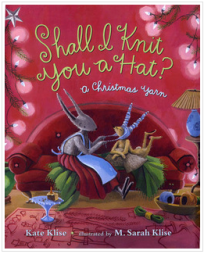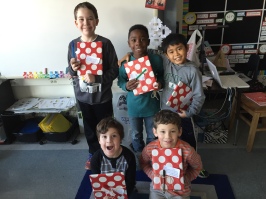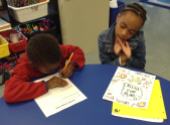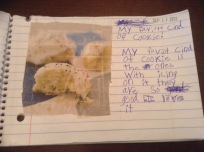I love it when thinking is nudged. I love it when someone asks as question that makes you think in a COMPLETELY different way than you were headed, and you are COMPLETELY surprised when it happened. Well, since my team is all working from the same writing plan this year (which is not really something I’ve ever done before!), there have naturally been some questions that have come up related to what we’re doing. Of course they have been, “Hey, tell me more about this…” kind of questions, not “What in the world were you thinking?” questions, which is nice. 🙂
So…you know we’ve been doing work with tiny notebooks as a way to introduce Writer’s Workshop this year. Well, eventually there comes a time when our 2nd grade writers will prove to to us that they are ready to graduate into their “real” Writer’s Notebooks. As a matter of habit, I guess, I put that step into the plan right around Day 12, when I figured that everyone would be ready; I’ve always done it that way with everyone on the same day (like here, and here).
 I proceeded normally, working a few days ahead of my team, which was nice so I could work out the kinks of the plan (I’d used this idea with older kids, but never with 2nd graders, so I wasn’t quite sure how it would work! LOL). Then one day, at a working lunch, the subject of notebooks came up again. Everyone wanted to know how I had decided to actually handle it, and what procedure I was going through to get them to my kiddos. I mentioned that I was going to plan Notebook Day for the following week, with everyone celebrating on the same day (which is again, the way I’ve always done it). The next thing that happened was really interesting. Most of my friends around the table just said, “Hmm….” and I could tell they were trying to work it out. They asked me about the purpose of teh tiny notebooks and how it didn’t make sense to do everyone’s Notebook Day on the same day if everyone was ready at different times. They were, after all, supposed to PROVE to me that they “got it.” I explained that the real thing behind the tiny notebooks was, in addition to teaching them how to use their “real” notebook, the expectation and anticipation of getting their new notebooks. I rationalized that I’d always gotten everyone on board in a really positive way and that maybe it didn’t really matter if they were ready; Notebook Day was more about the ceremony and excitement around being a writer. We agreed that probably everyone else was going to give individual kids their notebooks when they were ready, rather than all at once, and that I was probably going to go ahead with an all-class celebration. Most importantly, though, we agreed that there was no RIGHT way to do it. Personal choice and professional judgment was paramount here.
I proceeded normally, working a few days ahead of my team, which was nice so I could work out the kinks of the plan (I’d used this idea with older kids, but never with 2nd graders, so I wasn’t quite sure how it would work! LOL). Then one day, at a working lunch, the subject of notebooks came up again. Everyone wanted to know how I had decided to actually handle it, and what procedure I was going through to get them to my kiddos. I mentioned that I was going to plan Notebook Day for the following week, with everyone celebrating on the same day (which is again, the way I’ve always done it). The next thing that happened was really interesting. Most of my friends around the table just said, “Hmm….” and I could tell they were trying to work it out. They asked me about the purpose of teh tiny notebooks and how it didn’t make sense to do everyone’s Notebook Day on the same day if everyone was ready at different times. They were, after all, supposed to PROVE to me that they “got it.” I explained that the real thing behind the tiny notebooks was, in addition to teaching them how to use their “real” notebook, the expectation and anticipation of getting their new notebooks. I rationalized that I’d always gotten everyone on board in a really positive way and that maybe it didn’t really matter if they were ready; Notebook Day was more about the ceremony and excitement around being a writer. We agreed that probably everyone else was going to give individual kids their notebooks when they were ready, rather than all at once, and that I was probably going to go ahead with an all-class celebration. Most importantly, though, we agreed that there was no RIGHT way to do it. Personal choice and professional judgment was paramount here.
Well, the meeting ended and I went on with the rest of my day, but I COULD NOT get that conversation out of my head. I had a headache in a really good way. You know those kind? The ones when you know that you’re chewing on something really important and you’re actually ok that it hurts? (You don’t have those? I hope so, because it means that you’re surrounding yourself with really great people who challenge you to improve your practice and evaluate how you do things. 🙂 ). I finished out the day, still unsure how I would proceed, and went home to have the same conversation with Mr. Bearden. I was pretty sure that (while it wasn’t a right/wrong issue) he would side with me, agreeing that a whole-class Notebook Day was a great idea. Well…he didn’t. He was actually really great about asking many other questions about it, and making suggestions about how I could have better explained my thinking to my team. He sided agreed that my team’s thinking that “when you’re ready” is the best time for new notebooks.
I chewed and chewed, trying to figure out why I’d always done it that way, and whether or not it would (or should!) work for this particular group of kiddos. Why hadn’t I ever done it “when they were ready,” as I had always explained to my students it would be? Why had I always done notebooks as a one-size-fits-all type situation? Well, ok, honestly probably because it’s easier. Especially with bigger kids, I probably didn’t want to manage keeping track of who had their notebook and who didn’t, as well as not wanting students to feel like they weren’t good enough or good writers. The whole thing, after all, was based on helping kids see themselves as writers, learn to live like writers and WANT TO BE WRITERS. In my mind, any negative (or something they could perceive as negative) was a no-go.
But maybe a one-size-fits-all what this group needed. Maybe, since they’re younger writers and this is the very beginning of their lifelong journey as writers, this was the year that I changed my whole process and really did what I said I was about all along (novel idea, right?)? And really, now that I admit it, when does one-size-fits-all ever work for kids?
So I decided I’d jump in and change up the whole “real” notebook deal this time around. There are pieces of it that I knew I wanted to keep the same, but the “when” of the process would be different for this new group of kiddos. And you know what? It’s been totally great and then some. Better than I could have imagined, and the anticipation and excitement are actually increased since kiddos aren’t sure when their Notebook Day will come.
(But really they can be sure…read more here. 🙂 )






























































































